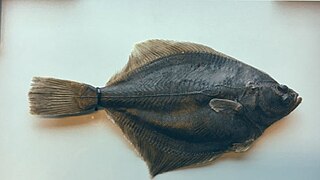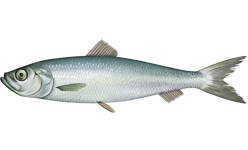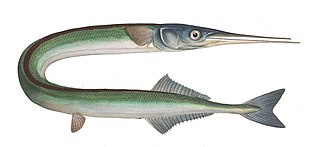 W
WThe European anchovy is a forage fish somewhat related to the herring. It is a type of anchovy; anchovies are placed in the family Engraulidae. It lives off the coasts of Europe and Africa, including in the Mediterranean Sea, the Black Sea, and the Sea of Azov. It is fished by humans throughout much of its range.
 W
WArgyrosomus regius is a fish of the family Sciaenidae. It is similar in form to a European seabass, with a pearly-silver coloration and a yellow-coloured mouth. Length can range from 40–50 cm to 2 m long, with weights up to 55 kg.
 W
WThe Baltic flounder is a species of flatfish endemic to the Baltic Sea, where it is the only known endemic fish species.
 W
WAtlantic herring is a herring in the family Clupeidae. It is one of the most abundant fish species in the world. Atlantic herrings can be found on both sides of the Atlantic Ocean, congregating in large schools. They can grow up to 45 centimetres (18 in) in length and weigh up to 1.1 kilograms (2.4 lb). They feed on copepods, krill and small fish, while their natural predators are seals, whales, cod and other larger fish.
 W
WThe black goby is a species of ray-finned fish found in the Eastern Atlantic and Mediterranean Sea and Black Sea. It inhabits estuaries, lagoons, and inshore water over seagrass and algae. It feeds on a variety of invertebrates and sometimes small fish. This species can also be found in the aquarium trade.
 W
WThe Atlantic cod is a benthopelagic fish of the family Gadidae, widely consumed by humans. It is also commercially known as cod or codling. Dry cod may be prepared as unsalted stockfish, as cured salt cod or clipfish.
 W
WCottus microstomus is a species of sculpin, a European freshwater fish in the family Cottidae. It is widespread in the Dniester drainage, Odra and Vistula drainages, most likely extending further east to the Gulf of Finland. It is part of the wider European Cottus gobio complex, and possibly makes hybrid zones with Cottus gobio and Cottus koshewnikowi. It is a demersal fish, up to 10.1 cm long.
 W
WCyclopterus lumpus, the lumpsucker or lumpfish, is a species of marine fish in the family Cyclopteridae (lumpsuckers). It is the only member of the genus Cyclopterus. It is found in the North Atlantic and adjacent parts of the Arctic Ocean, ranging as far south as Chesapeake Bay on the North American coast and Spain on the European coast.
 W
WThe European eel is a species of eel, a snake-like, catadromous fish. They are normally around 60–80 cm (2.0–2.6 ft) and rarely reach more than 1 m, but can reach a length of up to 1.5 m in exceptional cases.
 W
WThe European flounder is a flatfish of European coastal waters from the White Sea in the north to the Mediterranean and the Black Sea in the south. It has been introduced into the United States and Canada accidentally through transport in ballast water. It is caught and used for human consumption.
 W
WThe European perch, also known as the common perch, redfin perch, big-scaled redfin, English perch, Eurasian perch, Eurasian river perch, Hatch or in Anglophone parts of Europe, simply the perch, is a predatory species of the freshwater perch native to Europe and northern Asia. The species is a popular quarry for anglers, and has been widely introduced beyond its native area, into Australia, New Zealand, and South Africa. They have caused substantial damage to native fish populations in Australia and have been proclaimed a noxious species in New South Wales.
 W
WThe garfish, also known as the garpike or sea needle, is a pelagic, oceanodromous needlefish found in brackish and marine waters of the Atlantic Ocean, the Pacific Ocean and the Mediterranean, Caribbean, Black, and Baltic Seas.
 W
WThe common goby is a species of ray-finned fish native to fresh and brackish waters along the Atlantic and Baltic Sea coasts of Europe and northern Africa, with a range stretching from Norway to Morocco and Mauritania. It is also found in the Canary Islands. This species reaches a maximum length of 9 centimetres (3.5 in) TL.
 W
WThe two-spotted goby is a species of goby native to marine and brackish waters of the eastern Atlantic Ocean where it can be found from the Faeroes and Norway to the northwestern coast of Spain. It has also been recorded from Estonia though records from the Mediterranean Sea are uncertain. They are common on all coasts of the United Kingdom. This species can reach a length of 6 centimetres (2.4 in) TL.
 W
WThe greater weever is a benthic and demersal venomous marine fish of the family Trachinidae. The greater weever is widely distributed along the eastern Atlantic coastline from Norway to Morocco, extending to the Mediterranean, Aegean and Black Seas. Trachinus draco has been shown to occur in depths ranging from shallow water up to -150 meters where it inhabits mostly muddy or sandy grounds. Trachinus draco is mostly and notoriously known for its venomous spines that can inflict serious injuries on humans through accidental stinging. Because of these spines and its potent venom it is classified as one of the most venomous fishes in the Mediterranean. The name “weever” is thought to originate from the Anglo-Saxon word “wivre” which translates as “viper”.
 W
WThe painted goby is a small goby of Western European waters from Trondheim Fjord to Spain, the Canary Islands and is sometimes reported in the Mediterranean Sea. Also mentioned in the Black Sea. It lives at depths from 1 to 55 metres, preferring a gravelly or sandy environment. Its young may sometimes be found in tide pools. It feeds on amphipods and copepods.
 W
WThe northern pike is a species of carnivorous fish of the genus Esox. They are typical of brackish and fresh waters of the Northern Hemisphere. They are known simply as a pike in Britain, Ireland, and most of Eastern Europe, Canada and the United States.
 W
WThe broadnosed pipefish or deepnosed pipefish is a fish of the family Syngnathidae. It is native to the Eastern Atlantic from Vardø in Norway, Baltic Sea and the British Isles at north to Morocco at south. It is also found in the Mediterranean Sea, Black Sea and Sea of Azov. It is common in the coastal shallow waters, usually on reefs with seagrasses. This species is notable for its "broad" snout, which is as deep as its body.
 W
WRaitt's sand eel, also known as the lesser sand eel, is a small semi-pelagic ray-finned fish found in the North Atlantic Ocean. The Raitt's sand eel is member of the family Ammodytidae which includes all 31 species of sand eels, often referred to as sand lances. Contrary to their name sand eels, including Raitt's sand eel, are not true eels and instead belong to the order of “weever-like” fishes, the Trachiniformes.
 W
WThe sand goby, also known as a polewig or pollybait, is a species of ray-finned fish native to marine and brackish waters European waters from the Baltic Sea through the Mediterranean Sea and into the Black Sea where it occurs in sandy or muddy areas of inshore waters at depths of from 4 to 200 metres. This species can reach a length of 11 centimetres (4.3 in) TL. This species is sometimes kept in public aquariums. The sand goby is of a sandy colour, with darker markings on the sides and a creamy-white underside. In the breeding season the male fish has blue spot at the rear of the first dorsal fin, ringed with white. The fish has a slender body, and the head is about a quarter of the total length.
 W
WThe common seasnail is a small marine fish of the seasnail family (Liparidae) in the order Scorpaeniformes, the scorpionfishes and flatheads. It is found in the northeastern Atlantic Ocean where it lives on the seabed.
 W
WThe European sprat, also known as bristling, brisling, garvie, garvock, Russian sardine, russlet, skipper or whitebait, is a species of small marine fish in the herring family Clupeidae. Found in European waters, it has silver grey scales and white-grey flesh. Specific seas in which the species occurs include the Irish Sea, Black Sea, Baltic Sea and Sea of the Hebrides. The fish is the subject of fisheries, particularly in Scandinavia, and is made into fish meal, as well as being used for human consumption. When used for food it can be canned, salted, breaded, fried, boiled, grilled, baked, deep fried, marinated, broiled, and smoked.
 W
WThe straightnose pipefish is a species of pipefish which lives in brackish water in the northeastern Atlantic, the Baltic, Mediterranean and Black Sea.
 W
WThe viviparous eelpout, also known as the, viviparous blenny and European eelpout is an eelpout in the family Zoarcidae. It is notable for giving birth to live larvae. It is a common soup ingredient in Mediterranean countries. The bones are of greenish colour, due to a harmless pigment. Their skin is slimy and the color is variable.
 W
WThe zander, or pikeperch, is a species of ray-finned fish from the family Percidae, which includes the perches, ruffes and darters. It is found in freshwater and brackish habitats in western Eurasia. It is a popular game fish and has been introduced to a variety of localities outside its native range. It is the type species of the genus Sander.